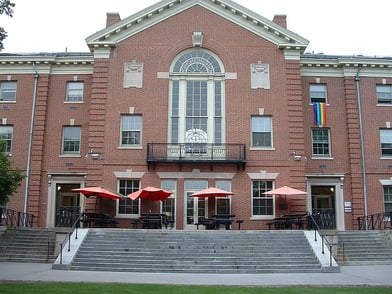When most people think of Title IX – the 1972 law that prohibits sex discrimination in public schools – they think of how it allowed women to take strides towards equality in sports. At one point in time I fell into this camp of people who simply equated Title IX with sports. Growing up as a female-assigned-at birth (FAAB) person, Title IX meant that I had the chance to compete in athletics all throughout school, including at the NCAA Division III collegiate level. However, when I began transitioning from female-to-male, Title IX took on a whole new meaning.
I was not “out” as transgender in high school, however I did begin questioning my gender. As a result, my gender expression became more masculine. Subsequently, my sophomore year of high school I started feeling isolated at school. I began facing occasional bullying because of my gender expression. My own experiences in high school spurred me to take action and move to Washington, D.C. when I was nineteen-years old to work on LGBTQ policy issues. When I started my advocacy work I quickly realized that Title IX could serve as a valuable tool to ensure that thousands of transgender high school students didn’t go through high school feeling as I did: alone and isolated.

The feeling of isolation I felt much of my academic career due to my gender and sexuality is common for LGBTQ youth. The 2015 National School Climate Survey conducted by the Gay, Lesbian and Straight Education Network (GLSEN) found that 57.6% of LGBTQ students felt unsafe at school. Over a third of LGBTQ students surveyed also reported avoiding gender-segregated spaces because they felt unsafe or uncomfortable. Recognizing the need for greater protections for transgender students, the U.S. Department of Education released guidance during the Obama administration stating that Title IX does protect transgender students in public schools from discrimination. The Department of Education releasing the guidance was a huge win for the thousands of transgender students nationwide and their supporters.
Shortly after the guidance was released I made another “transition” in my life; I was preparing to enter a teacher education graduate program at Brown University. I am currently in the final semester of my graduate program; completing my student-teaching at a public high school in Providence, Rhode Island. Every day I teach a class of wonderful and curious students. One of my students, Blake*, is transgender. When I look at Blake – as well as the rest of my students who are predominately low-income students of color - I am reminded why I went into teaching in the first place. Blake came into class a few weeks after the semester started, having transferred from another school in the area. Many would say the odds were already stacked against Blake, as a mid-semester transfer student and being transgender. But Blake has never seen things that way. Blake is incredibly courageous, bold, and intelligent. It was particularly emotional for me when Blake disclosed they were transgender. Blake came out to me shortly after Secretary of Education Betsy DeVos announced the repeal of the Title IX guidance - the very guidance that myself and so many of my friends had worked on for years.

Now more than ever Blake and other transgender students need and deserve supportive educators. When LGBTQ students have supportive educators in their lives - and supportive policies to back them up - they thrive. This year I have focused on training teachers to best serve and support LGBTQ students. I have done this work through my Point Community Service Project (CSP). Through my CSP, I have trained fifty pre-service educators at Brown University to ensure they have the tools necessary to best serve all students. For many of my colleagues, the initial training I presented was the first time any of them had any formal professional development on working with LGBTQ students. One student in my program, who will go on to be a secondary English teacher next school year, described the training as “transformational to his teaching practice.”

The future is unclear when it comes to the rights of LGBTQ students in schools. What is clear, however, is that there is momentum for transgender student advocacy and organizing. It is critical in this moment in time that school districts and teacher education programs are preparing teachers to meet the specific needs of LGBTQ students. Good professional development can fill the gaps left behind by Title IX guidance repeal, and allow educators to feel like they have the tools necessary to combat homophobia and transphobia in schools today. When transgender students are explicitly protected by law, and when educators know what resources they have at their disposal to ensure that transgender students are thriving and safe, everyone is better for it.
* Names have been changed to protect the privacy of individuals.

This post was written by Point Scholar Bryce Celotto.
Bryce is pursuing a Masters of Arts in Teaching degree with a focus in Secondary Social Studies/History education at Brown University. Upon completion of his graduate studies, Bryce plans to become a full-time public school educator in Southern California. Read more about Bryce here.

